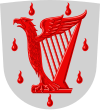Kangasala
| Kangasala | ||
|---|---|---|
| Municipality | ||
| Kangasalan kunta | ||

Lake Roine seen from Vehoniemi ridge
|
||
|
||
 |
||
| Coordinates: 61°28′N 024°04′E / 61.467°N 24.067°ECoordinates: 61°28′N 024°04′E / 61.467°N 24.067°E | ||
| Country |
|
|
| Region | Pirkanmaa | |
| Sub-region | Tampere sub-region | |
| Charter | 1865 | |
| Government | ||
| • Municipal manager | Oskari Auvinen | |
| Area (2016-01-01) | ||
| • Total | 658.04 km2 (254.07 sq mi) | |
| • Land | 658.02 km2 (254.06 sq mi) | |
| • Water | 212.83 km2 (82.17 sq mi) | |
| Area rank | 130th largest in Finland | |
| Population (2016-03-31) | ||
| • Total | 30,686 | |
| • Rank | 36th largest in Finland | |
| • Density | 46.63/km2 (120.8/sq mi) | |
| Population by native language | ||
| • Finnish | 98.3% (official) | |
| • Swedish | 0.3% | |
| • Others | 1.4% | |
| Population by age | ||
| • 0 to 14 | 20.7% | |
| • 15 to 64 | 64.7% | |
| • 65 or older | 14.7% | |
| Time zone | EET (UTC+2) | |
| • Summer (DST) | EEST (UTC+3) | |
| Municipal tax rate | 20% | |
| Website | www.kangasala.fi | |
Kangasala is a municipality in Finland, next to Tampere. It was founded in 1865. The municipality has a population of 30,686 (31 March 2016) and covers an area of 658.04 square kilometres (254.07 sq mi) of which 212.83 km2 (82.17 sq mi) is water. The population density is 46.63 inhabitants per square kilometre (120.8/sq mi).
It is famous for its natural beauty, as depicted by Zacharias Topelius in his poem Kesäpäivä Kangasalla (made into a song by Gabriel Linsén). It is also known for its mansions, such as Liuksiala where Swedish queen Karin Månsdotter lived, and Wääksy. Kangasala has a long history of tourism.
The lakes Roine, Längelmävesi and Vesijärvi are located in Kangasala. Of these the two first are mentioned in the famous poem, and Vesijärvi is the lake by which the scenic overlook described in the lyrics is situated.
The municipality of Sahalahti was consolidated to Kangasala on 1 January 2005, and the municipality of Kuhmalahti on 1 January 2011.
Kangasala was a popular destination already in the 18th century. The water of the Kuohu Spring (Kuohunlähde) was believed to have healing effects. At that time, refreshing in a health spa bathing, taking outdoor exercise and enjoying healing waters was fashionable amongst the . It was also why the first real tourists in Kangasala came to spend their holidays there.
A water well building was built by the Kuohu Spring which was a little later followed by a separate restaurant and hotel building. Even people from more distant places came to refresh themselves there, preferably at least once a year. At the same time travelers had a good chance to exchange news, discuss with each other and find out about the latest trends of fashion. Spa tourism can probably be considered a predecessor of modern holidaymaking. At that time, however, it was primarily a pastime of the noble and the prosperous bourgeoisie only.
...
Wikipedia

